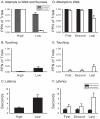Infants' perception of affordances of slopes under high- and low-friction conditions
- PMID: 20695700
- PMCID: PMC3648889
- DOI: 10.1037/a0017450
Infants' perception of affordances of slopes under high- and low-friction conditions
Abstract
Three experiments investigated whether 14- and 15-month-old infants use information for both friction and slant for prospective control of locomotion down slopes. In Experiment 1, high- and low-friction conditions were interleaved on a range of shallow and steep slopes. In Experiment 2, friction conditions were blocked. In Experiment 3, the low-friction surface was visually distinct from the surrounding high-friction surface. In all three experiments, infants could walk down steeper slopes in the high-friction condition than they could in the low-friction condition. Infants detected affordances for walking down slopes in the high-friction condition, but in the low-friction condition, they attempted impossibly slippery slopes and fell repeatedly. In both friction conditions, when infants paused to explore slopes, they were less likely to attempt slopes beyond their ability. Exploration was elicited by visual information for slant (Experiments 1 and 2) or by a visually distinct surface that marked the change in friction (Experiment 3).
Figures






References
-
- Adolph KE. A psychophysical assessment of toddlers’ ability to cope with slopes. Journal of Experimental Psychology: Human Perception and Performance. 1995;21:734–750. - PubMed
-
- Adolph KE. Learning in the development of infant locomotion. Monographs of the Society for Research in Child Development. 1997;62(3) Serial No. 251. - PubMed
-
- Adolph KE. Learning to keep balance. In: Kail R, editor. Advances in child development and behavior. Vol. 30. Elsevier Science; Amsterdam: 2002. pp. 1–30. - PubMed
-
- Adolph KE, Avolio AM. Walking infants adapt locomotion to changing body dimensions. Journal of Experimental Psychology: Human Perception and Performance. 2000;26:1148–1166. - PubMed
-
- Adolph KE, Badaly D, Garciaguirre JS, Sotsky R. 15,000 steps: Infants’ locomotor experience. 2009. Manuscript in revision.

